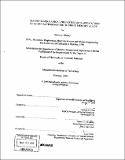Magneto-mechanical properties and applications of Ni-Mn-Ga ferromagnetic shape memory alloy
Author(s)
Murray, Steven J. (Steven James), 1974-
DownloadFull printable version (10.05Mb)
Other Contributors
Massachusetts Institute of Technology. Dept. of Materials Science and Engineering.
Advisor
Samuel M. Allen and Robert C. O'Handley.
Terms of use
Metadata
Show full item recordAbstract
Ferromagnetic shape memory alloys (FSMA's) have shown large strains under magnetic field as magnetic variants in the rnartensite rearrange to accommodate the applied field. The theoretical maximum field-induced strain is 6.3% in Ni-Mn-Ga FSMA, and results of 6.1% are presented. These strain establish FSMA's as a new class of active materials with strains much larger than piezoelectric or magnetostrictive actuators. This work looks at Ni-Mn-Ga FSMA and explores the correlation between structure and properties, field induced strain at various stresses, and devices based on this new class of active materials. Martensitic Ni-Mn-Ga was found to have a tetragonal 14/mmm crystal structure with a cla ratio of 1.3 3. Twinning can occur on the { 112} planes. A twin boundary in such a crystal should cause a change of direction in the crystal axes of 7 .1 degrees. This angle was measured at 6.5 degrees in a single crystal of Ni-Mn-Ga. Twin angles and strains in the material are dependent on c/a. Surface magnetization measurements show that for this sample each variant is dominated by a single direction of magnetization, with a change in magnetization at the twin boundary. Using a constrained sample technique, the rnagnetocrystalline anisotropy was measured at 0.16 MJ/m3, and the permeability was measured at 22 along the easy axis of the crystal and 2.1 along the hard axis. A model is proposed which predicts a threshold type strain behavior both with internal field at constant stress, and with stress at constant internal field. An experimental apparatus was built to test these conditions. The predictions of the model were largely verified in experiment and field-induced strains up to 6.1 % are measured. Blocking stress matched that predicts at about 1. 7 MP a A prototype magnetic actuator based on Ni-Mn-Ga was built to demonstrate the feasibility of the technology. lbis actuator applied fields of up to 600 kNm to a slender sample in the transverse direction. A maximum deflection of 1.6 mm is achieved for an active material length of 41 mm. AC testing shows the response degrades at frequencies above a few Hz.
Description
Thesis (Ph.D.)--Massachusetts Institute of Technology, Dept. of Materials Science and Engineering, 2000. Vita. Includes bibliographical references (p. 151-155).
Date issued
2000Department
Massachusetts Institute of Technology. Department of Materials Science and EngineeringPublisher
Massachusetts Institute of Technology
Keywords
Materials Science and Engineering.